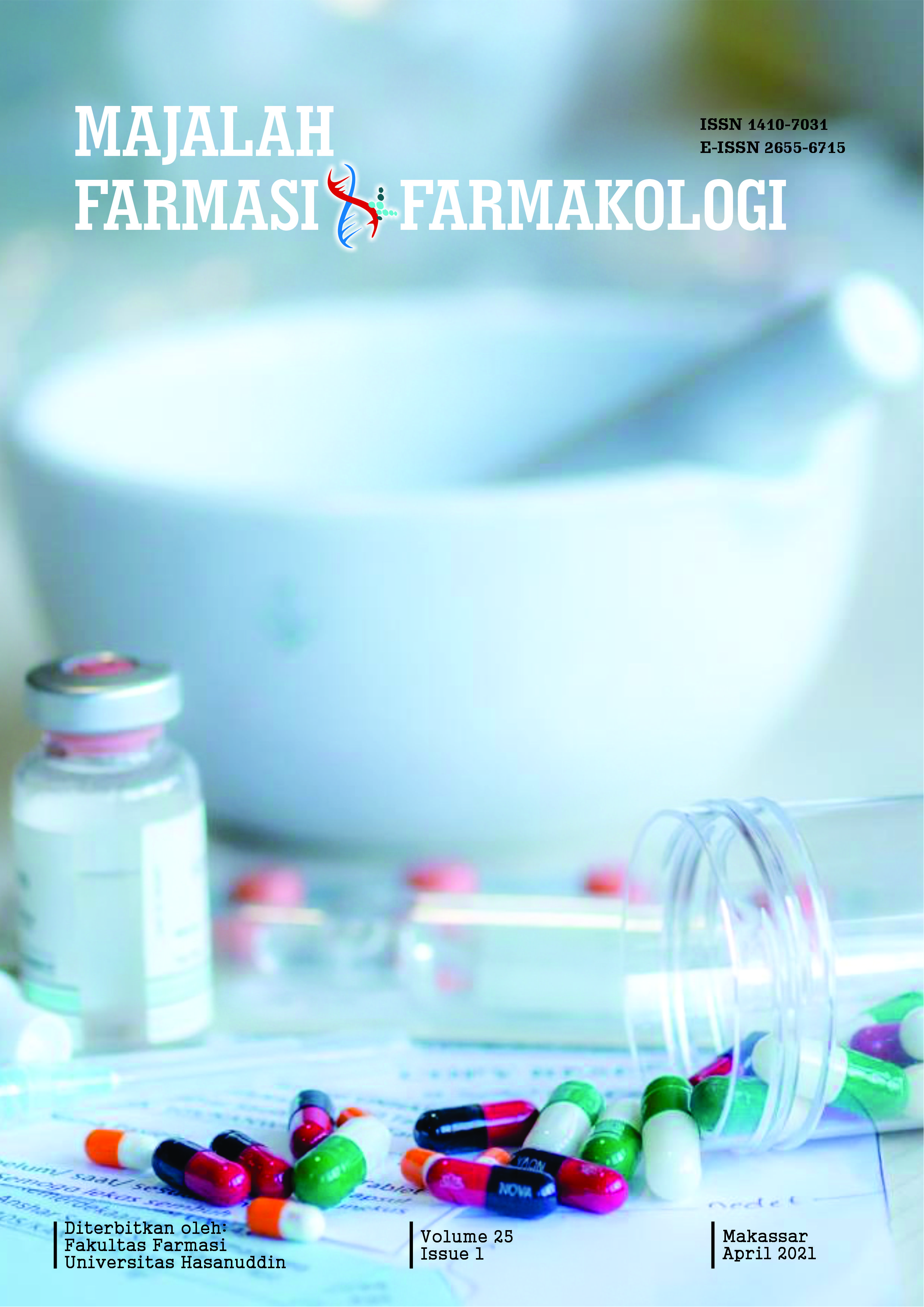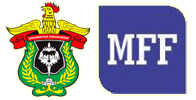FORMULASI, EVALUASI MUTU FISIK, DAN UJI SPF KRIM TABIR SURYA BERBAHAN DASAR RUMPUT LAUT E. cottonii
Keywords:
E. cottonii, krim, tabir surya, Sun Protecting FactorAbstract
E. cottonii merupakan salah satu makroalga merah yang mengandung senyawa Mycosporine-like amino acids
(MAAs) yang mempunyai aktivitas mengabsorpsi radiasi UV-A dan UV-B sehingga E. cottonii bisa dikembagkan
untuk menjadi produk krim tabir surya. Penelitian ini bertujuan untuk mendapatkan formulasi krim tabir surya
berbahan dasar E. cottonii yang tepat sehingga didapatkan produk krim tabir surya dari E. cottonii yang
memiliki mutu fisik yang baik melalui uji pH, uji viskositas, uji daya sebar, memiliki stabilitas fisik yang baik
serta nilai SPF yang maksimal. Metode dalam penelitian ini merupakan metode eksperimen laboratorium.
Bubur E. cottonii diformulasi menjadi krim tabir surya dengan mencampurkannya kedalam basis krim yang
telah dibuat. Krim dibuat dengan mencampurkan bubur E. cottonii dengan jumlah yang berbeda kedalam
basis krim (F0). Formula dibuat sebanyak tiga macam dengan mencampurkan 5 gram bubur E. cottonii ke
dalam F0 (F1), 15 gram bubur E. cottonii ke dalam F0 (F2), dan 25 gram bubur E. cottonii ke dalam F0 (F3).
Krim yang telah dibuat kemudian di evaluasi mutu fisiknya yang meliputi uji organoleptis dan homogenitas, uji
viskositas, uji daya sebar, dan uji pH. Kemudian dilakukan penentuan nilai Sun Protecting Factor (SPF) krim
dengan menggunakan spektrofotometri UV-VIS. Hasil evaluasi menunjukkan bahwa krim F0, F1, F2, dan F3
tidak mengalami perubahan secara organoleptis, homogenitas, pH dan viskositas selama empat minggu.
Sediaan krim F1, F2, dan F3 memenuhi daya sebar yang baik yaitu 5-7 cm. Nilai viskositas F0, F1, F2, dan F3
memenuhi persyaratan krim yang baik yaitu berkisar antara 7.500-28.500 cPs selama penyimpanan empat
minggu. Nilai pH F0, F1, F2, dan F3 sesuai dengan SNI dan pH balance kulit normal manusia yaitu berkisar
antara 5,5-6,3. Formula terbaik yang memiliki nilai SPF maksimal adalah krim dengan penambahan bubur E.
cottonii 25 gram (F3) yaitu 10,9.
References
Talarosha B., 2005. Menciptakan kenyamanan thermal dalam bangunan. Jurnal Sistem Teknik Industri 6(3):2 – 12.
Coba, F. De La., Aguilera, J., Figueroa, F.L. 2008. Antioxidant Activity of Mycosporine-like Amino Acids Isolated from Three Red Macroalgae an One Marine Lichen. J. Appl Phycol. 21: 161-169.
Wright CY, Norval M, Summers B, Davids L, Coetzu G, Oriowo MO. 2012. The impact of solar ultraviolet radiation on human health in Sub Sahara Africa. S. Afr. J. Sci.;108:1-6.
Suryanto, E., 2012. Fitokimia Antioksidan. Surabaya: Penerbit Putra Media Nusantara.
Luthfiyana, N., Nurjanah, Nurilmala, M., Anwar, E., Hidayat, T., 2016. Rasio Bubur Rumput Laut E. cottonii Dan Sargassum Sp. Sebagai Formula Krim Tabir Surya. JPHPI, 19(3): 183-195.
Yanuarti, R., Nurjanah, Anwar, E., Pratama, G., 2017. Kandungan Senyawa Penangkal Sinar Ultra Violet dari Ekstrak Rumput Laut E. cottonii dan Turbinaria conoides. Biosfera, 34 (2): 51-58.
Salim, Z., Ernawati, 2015. Info Komoditi Rumput Laut. Badan Pengkajian dan Pengembangan Kebijakan Perdagangan. Jakarta: 63.
Wada, Naoki., Sakamoto, Toshio., Matsugo, Seiichi. 2015. Mycosporinelike Amino Acids and Their Derivatives as Natural Antioxidants. Antioxidants 4: 603-646.
Reymon, Lallo, S., Manggau, M.A., 2018. Identifikasi Senyawa Mycosporine-Like Amino Acids Dari Fraksi Etanol E. cottonii Menggunakan Spektrofotometer UV. MFF; 22(2):48-51.
Maharany, F., Nurjanah, Suwandi, R., Anwar, E., Hidayat, T., 2017. Bioactive Compounds of Seaweed Padina australis and E. cottonii as Sunscreen Raw Materials. JPHPI; 20(1): 10-17).
Anggadiredja T, Zatnika A, Purwoto H, Istini S. 2006. Rumput Laut. Jakarta: Penebar Swadaya. Hal. 26-38.
Tranggono, R.I., Latifah, F. 2007. Buku Pegangan Ilmu Pengetahuan Kosmetik. Jakarta: PT. Gramedia Pustaka Utama.
[SNI] Standar Nasional Indonesia 164399. 1996. Sediaan Tabir Surya. Jakarta: Badan Standarisasi Nasional.
Sharon, N., Anam, S., Yuliet. 2013. Formulasi krim ekstrak etanol bawang hutan (Eleutherine palmifolia L.). Natural Science: Journal of Science and Technology, vol 2(3):111-122.
Wasitaatmadja, S.M. 1997. Penuntun Ilmu Kosmetik Medik. Jakarta: UI Press.
Gröniger A, Sinha RP, Klisch M, Häder DP. 2000. Photoprotective compounds in cyanobacteria, phytoplankton and macroalgae–a database. Journal Photochem Photobiol. B: Biology 58:115–122.
Damogalad V, Edy HJ, Supriati HS. 2013. Formulasi krim tabir surya ekstrak kulit nanas (Ananas comosus L. Merr) dan uji in vitro nilai sun protecting factor (SPF). Pharmacon. Jurnal Ilmiah Farmasi UNSRAT 2(2): 12 – 16.
Downloads
Published
Issue
Section
License
Copyright (c) 2021 Majalah Farmasi dan Farmakologi

This work is licensed under a Creative Commons Attribution-NonCommercial 4.0 International License.
The copyright to this article is transferred to Universitas Hasanuddin (UNHAS) if and when the article is accepted for publication. The undersigned hereby transfers all rights in and to the paper including without limitation all copyrights to UNHAS. The undersigned hereby represents and warrants that the paper is original and that he/she is the author of the paper, except for material that is clearly identified as to its original source, with permission notices from the copyright owners where required. The undersigned represents that he/she has the power and authority to make and execute this assignment.
We declare that:
- This paper has not been published in the same form elsewhere.
- It will not be submitted anywhere else for publication prior to acceptance/rejection by this Journal.
- A copyright permission is obtained for materials published elsewhere and which require this permission for reproduction.
Furthermore, I/We hereby transfer the unlimited rights of publication of the above-mentioned paper in whole to UNHAS The copyright transfer covers the exclusive right to reproduce and distribute the article, including reprints, translations, photographic reproductions, microform, electronic form (offline, online) or any other reproductions of similar nature.
The corresponding author signs for and accepts responsibility for releasing this material on behalf of any and all co-authors. This agreement is to be signed by at least one of the authors who have obtained the assent of the co-author(s) where applicable. After submission of this agreement signed by the corresponding author, changes of authorship or in the order of the authors listed will not be accepted.


